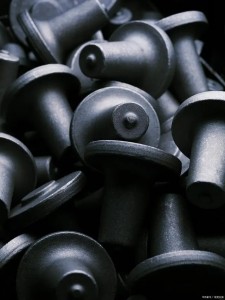There are 5+ main sintering methods and processes for silicon carbide ceramics.
1. Hot press sintering
Due to its covalent nature, silicon carbide is difficult to prepare high-density materials using the atmospheric pressure sintering method commonly used for ion bonded materials. It is necessary to add a second phase or use some special process methods to promote its densification and sintering. Hot pressing sintering is a good method. Pure SiC powder hot pressing sintering can approach the theoretical density, but requires high temperature (2000 ℃) and high pressure (>350MPa). The use of second phase additives can strongly promote its densification rate, significantly reduce sintering temperature and pressure, and obtain SiC ceramic materials with a density close to the theoretical density. Research has shown that B is the most effective additive, and the relative density of SiC ceramics prepared by adding 0.8% boron at 1950 ℃, pressure of 70MPa, and insulation for 30 minutes is greater than 95%. The reason is that B can dissolve in SiC and promote sintering. Further research has shown that the presence of free carbon is an important factor in promoting sintering. According to experiments with different amounts of C and B, the maximum amount of B added is 0.36%. At 2100 ℃, the solubility of B in SiC is 0.2%. The remaining B forms B4C with C and dissolves into SiC to form a solid solution, which is also beneficial for promoting sintering. In addition, commonly used additives include Al2O3, AlN, and BN, which either form a solid solution with SiC or form a liquid phase with other substances to promote sintering.
02. Pressureless sintering
It is impossible to use atmospheric pressure sintering method for pure SiC, but it is entirely possible to choose additives appropriately and control the purity, particle size, and phase composition of SiC. When using ultrafine (sub micron level) β- SiC, with an oxygen content of less than 0.2%, was sintered at atmospheric pressure in an inert atmosphere or vacuum at 1950~2100 ℃ with the addition of 0.5% B and 1.0% C, resulting in almost completely dense SiC ceramics. Normal pressure sintering is very beneficial for industrial production.
03. Reaction sintering
Reactive sintering utilizes α- After mixing and pressing SiC powder and graphite powder in a certain proportion to form a green body, it is heated to around 1650 ℃, and at the same time, Si is melted or infiltrated into the green body through gas-phase Si, causing it to react with graphite to generate β- SiC, replace the original α- SiC particles combine. If complete Si infiltration is allowed, a material with zero porosity and no size change can be obtained throughout the entire process, which is the biggest characteristic of reaction sintered SiC. Although the ceramic prepared by this method has a dense texture, its application temperature is limited due to the presence of a considerable amount of Si. In actual production, there should be excessive pores in the billet to prevent the formation of an impermeable SiC layer on the surface due to the Si infiltration process, which hinders the continued reaction sintering process. The excess pores are filled with Si, and the final product consists of about 90% to 92% SiC and about 8% to 10% Si.
4. Recrystallization sintering
5. Other materials combined with silicon carbide sintering
For example: clay bonded silicon carbide, mullite bonded silicon carbide, silicon nitride bonded silicon carbide, graphite bonded silicon carbide

Post time: Aug-28-2023





